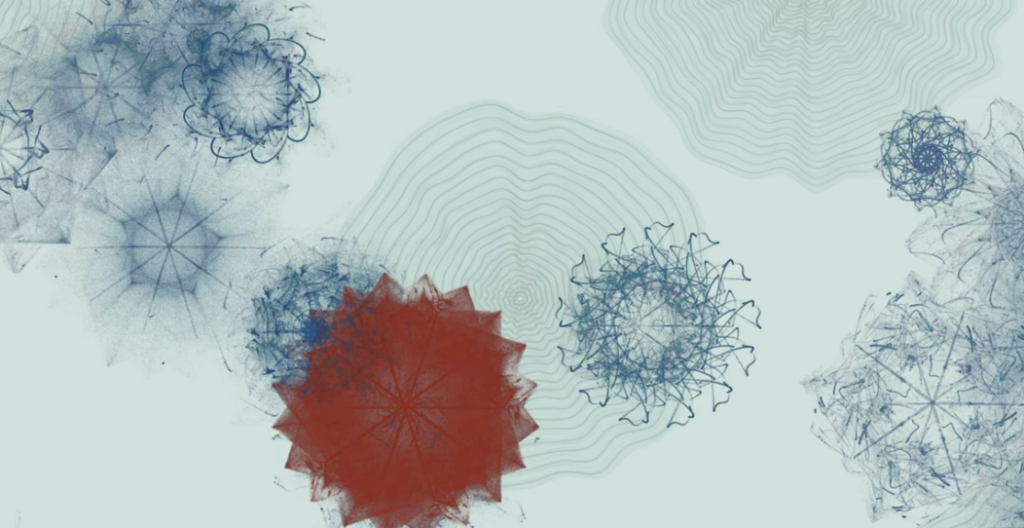Ai-Da, a robot, draws her reflection in a silent Oxfordshire gallery with remarkable accuracy. Her mechanical hands move elegantly, using geometry to interpret emotion. Because of what it evokes rather than who painted it, the final portrait has a profoundly human feel. It serves as a powerful reminder that technology, which was formerly only analytical, is now remarkably emotional.
The intersection of logic and emotion, where artists and engineers work together to produce beauty through computation, is known as algorithmic art. Early pioneers such as Frieder Nake and Vera Molnár thought that algorithms could mathematically express emotion. Today’s hybrid creators, who view code as a living brushstroke, were made possible by their conviction. The notion of a machine learning to feel its way through creation almost seems poetic.
This relationship has been especially inventive thanks to artists like Sougwen Chung. By using her own brush movements to train robotic systems, she produces works that resemble dialogues between data and intuition. Similar to a musician and their instrument learning to anticipate each other’s notes, each piece of art is a duet that combines algorithmic improvisation with human rhythm. The results are unexpectedly moving and remarkably effective.
| Aspect | Description |
|---|---|
| Concept | Explores how algorithms and artificial intelligence create emotionally resonant art that challenges the definition of creativity. |
| Key Figures | Ai-Da (robot artist), Vera Molnár, Frieder Nake, Sougwen Chung, Harold Cohen. |
| Core Idea | Algorithms are evolving from technical tools into creative collaborators capable of simulating emotional depth. |
| Benefits | Expands creative possibilities, democratizes art-making, and encourages cross-disciplinary collaboration. |
| Concerns | Raises debates about authorship, authenticity, and the emotional limits of machines. |
| Societal Impact | Forces a rethinking of artistic identity and emotional expression in the digital age. |
| Reference | BBC – AI Art: The End of Creativity or the Start of a New Movement? |

Stanford University researchers went one step further and trained an AI to “interpret” art on an emotional level. It examined works of art and gave emotional descriptions of them, such as “melancholic calm” for Rothko’s color fields and “restless wonder” for Van Gogh’s Starry Night. Despite being algorithmic, the experiment showed something important: emotion could be modeled even if it wasn’t truly felt. The distinction between empathy and imitation became very evident.
Algorithmic art is no longer limited to experimental labs at major exhibitions. It has made its way into museums, mainstream galleries, and even high-end auctions. By fusing data visualization with sensory experience, Refik Anadol’s immersive digital installations have significantly increased public engagement with art. His works, which turn human memories into glistening visual symphonies, demonstrate that emotion can be created using code rather than merely deciphered.
People’s emotional attachment to these pieces is both intriguing and a little unnerving. When technology too closely resembles us, we start to doubt reality. Despite Ai-Da’s unconsciousness, her portraits, for example, arouse empathy. According to her designers, she is a “mirror of human behavior,” a device that compels us to examine our own emotional tendencies. That confrontation is particularly beneficial — it makes us rethink creativity as something shared, not owned.
The authorship controversy is still complicated. In order to prevent AI systems from unfairly consuming human-made work, artists Holly Herndon and Mat Dryhurst have turned into ardent supporters of fair creative use. Their project, Spawning AI, allows artists to track whether their creations have been used in algorithmic training. Their support is in line with a growing body of opinion that says that art cannot be morally acceptable if it disregards the feelings of its human creators.
Nevertheless, the combination of technology and art is incredibly transformative. Through the use of neural networks, artists can now create works that change color or form in real time in response to audience behavior. In certain exhibitions, the voices or heartbeats of visitors are incorporated into the artwork. The painting appears to be alive, sensing, reacting, and breathing through the audience’s combined presence, creating an intimate effect.
A whole new ecosystem of creativity is emerging. Instead of being competitive, the process is now collaborative. Artists are not being replaced by machines; rather, their creative potential is being increased. Algorithms are given technical accuracy, freeing up human creators to focus on meaning, emotion, and concepts. Technology streamlines execution while humans craft the narrative, creating a delicate yet potent balance.
Emotionally aware AI is also finding its way into therapeutic and educational spaces. For instance, generative algorithms can identify color patterns linked to particular emotions in art therapy and adjust accordingly. This ability is especially helpful for articulating emotions that are difficult for people to express. Therapy becomes more about emotional exploration and less about accuracy with machine-guided visuals.
Algorithmic art is becoming a popular way for celebrities to express their culture. Grimes has experimented with artificial intelligence (AI)-generated soundscapes that mimic her emotional range and vocal tone, characterizing the process as “creating with a parallel self.” Similarly, Pharrell Williams has invested in digital art startups that use generative models to design evolving fashion patterns. These partnerships show how technology can enhance individuality rather than lessen it.
Our fascination with artificial emotion also has a profoundly human quality. These coded creations reflect who we are. Even if it was created by a robot, a painting that conveys awe or loneliness reflects back our desire for connection. Art has always been a mirror of human experience — now it’s a mirror polished by data, glowing with digital empathy.


